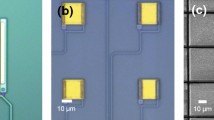Abstract
We performed small-scale demonstrations at GSFC of high-resolution X-ray TES microcalorimeters read out using a microwave SQUID multiplexer. This work is part of our effort to develop detector and readout technologies for future space-based X-ray instruments such as the microcalorimeter spectrometer envisaged for Lynx, a large mission concept under development for the Astro 2020 Decadal Survey. In this paper we describe our experiment, including details of a recently designed, microwave-optimized low-temperature setup that is thermally anchored to the 55 mK stage of our laboratory ADR. Using a ROACH2 FPGA at room temperature, we read out pixels of a GSFC-built detector array via a NIST-built multiplexer chip with Nb coplanar waveguide resonators coupled to rf-SQUIDs. The resonators are spaced 6 MHz apart (at \(\sim \) 5.9 GHz) and have quality factors of \(\sim \) 15,000. In our initial demonstration, we used flux-ramp modulation frequencies of 125 kHz to read out 5 pixels simultaneously and achieved spectral resolutions of 2.8–3.1 eV FWHM at 5.9 keV. Our subsequent work is ongoing: to-date we have achieved a median spectral resolution of 3.4 eV FWHM at 5.9 keV while reading out 28 pixels simultaneously with flux-ramp frequencies of 160 kHz. We present the measured system-level noise and maximum slew rates and briefly describe our future development work.






Similar content being viewed by others
Notes
We use a HEMT from Low-Noise Factory (Model LNF-LNC4_8C) that has a noise temperature of 2.3 K.
We posit that a temperature gradient across the array was established due to particle debris causing heating on the nearby MUX chip. The pixels closest to the MUX chip showed the smallest pulse heights (consistent with an elevated heat-sink temperature) whereas the pixels farthest from the MUX chip showed pulse heights similar to those expected for a heat-sink temperature of 55 mK. Following this experiment, debris was identified on the MUX chip and removed; the pulse-height gradient was not observed on prior or subsequent tests.
References
J.A. Gaskin et al., Proc. SPIE 10397, 103970S (2017). https://doi.org/10.1117/12.2273911
S.J. Smith, S.R. Bandler, R.P. Brekosky, A.-D. Brown, J.A. Chervenak, M.E. Eckart, E.F.-Feliciano, F.M. Finkbeiner, R.L. Kelley, C. A. Kilbourne, F.S. Porter, J.E. Sadleir, IEEE Trans. Appl. Supercond. 19 (2009). https://doi.org/10.1109/TASC.2009.2019557
J.A.B. Mates, G.C. Hilton, K.D. Irwin, L.R. Vale, K.W. Lehnert, Appl. Phys. Lett. 92 (2008). https://doi.org/10.1063/1.2803852
J.A.B. Mates, D.T. Becker, D.A. Bennett, B.J. Dober, J.D. Gard, J.P. Hays-Wehle, J.W. Fowler, G.C. Hilton, C.D. Reintsema, D.R. Schmidt, D.S. Swetz, L.R. Vale, J.N. Ullom, Appl. Phys. Lett. 111 (2017). https://doi.org/10.1063/1.4986222
C.D. Reintsema, J. Beall, W. Doriese, W. Duncan, L. Ferreira, G.C. Hilton, K.D. Irwin, D. Schmidt, J. Ullom, L. Vale, Y. Xu, J. Low Temp. Phys. 151, 927–933 (2007). https://doi.org/10.1007/s10909-008-9769-7
K.M. Morgan, B.K. Alpert, D.A. Bennett, E.V. Denison, W.B. Doriese, J.W. Fowler, J.D. Gard, G.C. Hilton, K.D. Irwin, Y.I. Joe, G.C. O’Neil, C.D. Reintsema, D.R. Schmidt, J.N. Ullom, D.S. Swetz, Appl. Phys. Lett. 109 (2016). https://doi.org/10.1063/1.4962636
A. Fleischmann, C. Enss, G.M. Seidel, Metallic magnetic calorimeters, in cryogenic particle detection, Topics in Applied Physics, ed. by C. Enss, vol. 99, pp. 151–216 (2005)
J.A.B. Mates, K.D. Irwin, L.R. Vale, G.C. Hilton, J. Gao, K.W. Lehnert, J. Low Temp. Phys. 167 (2012). https://doi.org/10.1007/s10909-012-0518-6
O. Noroozian, J.A.B. Mates, D.A. Bennett, J.A. Brevik, J.W. Fowler, J. Gao, G.C. Hilton, R.D. Horansky, K.D. Irwin, Z. Kang, D.R. Schmidt, L.R. Vale, J.N. Ullom, Appl. Phys. Lett. 103 (2013). https://doi.org/10.1063/1.4829156
C.A. Kilbourne, W.B. Doriese, S.R. Bandler, R.P. Brekosky, A.-D. Brown, J.A. Chervenak, M.E. Eckart, F.M. Finkbeiner, G.C. Hilton, K.D. Irwin, N. Iyomoto, R.L. Kelley, F.S. Porter, C.D. Reintsema, S.J. Smith, J.N. Ullom, Proc. SPIE 7011, 701104–701107 (2008)
E.J. Wassell et al., IEEE Trans. Appl. Supercond. 27(4) (2017). https://doi.org/10.1109/TASC.2016.2633783
S.J. Smith, J.S. Adams, C.N. Bailey, S.R. Bandler, S.E. Busch, J.A. Chervenak, M.E. Eckart, F.M. Finkbeiner, C.A. Kilbourne, R.L. Kelley, S.-J. Lee, J.-P. Porst, F.S. Porter, J.E. Sadleir, J. Appl. Phys. 114 (2013). https://doi.org/10.1063/1.4818917
Author information
Authors and Affiliations
Corresponding author
Rights and permissions
About this article
Cite this article
Yoon, W., Adams, J.S., Bandler, S.R. et al. Toward Large Field-of-View High-Resolution X-ray Imaging Spectrometers: Microwave Multiplexed Readout of 28 TES Microcalorimeters. J Low Temp Phys 193, 258–266 (2018). https://doi.org/10.1007/s10909-018-1917-0
Received:
Accepted:
Published:
Issue Date:
DOI: https://doi.org/10.1007/s10909-018-1917-0




